Flood Exposure Patterns Induced by Sea Level Rise in Coastal Urban Areas of Europe and North Africa
Abstract
1. Introduction
2. Materials and Methods
2.1. Data on European and North African Cities
2.2. Statistical Analysis of Cities Prone to Sea Storm Flooding
- If R > Rcrit, the city was marked as an outlier;
- If R ≤ Rcrit, the city was not considered an outlier.
2.3. National Level Data for At-Risk Groups in Coastal Flooded Areas
3. Results
3.1. Storm Risk in European and North African Coastal Cities
3.2. Results of the Socioeconomic Analysis Related to Flood-Prone Areas
4. Discussion
4.1. Flood Events and Storm Surges in European–Mediterranean Coastal Areas
4.2. The Impact of Storm Surges and Rising Sea Levels on the Residents of Coastal Cities
4.3. Social and Economic Factors of Potentially Flooded Areas
5. Conclusions
Author Contributions
Funding
Data Availability Statement
Conflicts of Interest
References
- Prokic, M.N.; Savić, S.; Pavić, D. Pluvial flooding in urban areas across the European continent. Geogr. Pannonica 2019, 23, 216–232. [Google Scholar] [CrossRef]
- Laino, E.; Iglesias, G. Beyond coastal hazards: A comprehensive methodology for the assessment of climate-related hazards in European coastal cities. Ocean Coast. Manag. 2024, 257, 107343. [Google Scholar] [CrossRef]
- Bevacqua, E.; Maraun, D.; Vousdoukas, M.I.; Voukouvalas, E.; Vrac, M.; Mentaschi, L.; Widmann, M. Higher probability of compound flooding from precipitation and storm surge in Europe under anthropogenic climate change. Sci. Adv. 2019, 5, eaaw5531. [Google Scholar] [CrossRef] [PubMed]
- Moncoulon, D.; Veysseire, M.; Naulin, J.P.; Wang, Z.X.; Tinard, P.; Desarthe, J.; Déqué, M. Modelling the evolution of the financial impacts of flood and storm surge between 2015 and 2050 in France. Int. J. Saf. Secur. Eng. 2016, 6, 141–149. [Google Scholar] [CrossRef]
- Machado Toffolo, M.; Grilli, F.; Prandi, C.; Goffredo, S.; Marini, M. Extreme Flooding Events in Coastal Lagoons: Seawater Parameters and Rainfall over A Six-Year Period in the Mar Menor (SE Spain). J. Mar. Sci. Eng. 2022, 10, 1521. [Google Scholar] [CrossRef]
- Kron, W.; Löw, P.; Kundzewicz, Z.W. Changes in risk of extreme weather events in Europe. Environ. Sci. Policy 2019, 100, 74–83. [Google Scholar] [CrossRef]
- Jiménez, J.A.; Valdemoro, H.I.; Bosom, E.; Sánchez-Arcilla, A.; Nicholls, R.J. Impacts of sea-level rise-induced erosion on the Catalan coast. Reg. Environ. Chang. 2017, 17, 593–603. [Google Scholar] [CrossRef]
- Brunel, C.; Sabatier, F. Potential influence of sea-level rise in controlling shoreline position on the French Mediterranean Coast. Geomorphology 2009, 107, 47–57. [Google Scholar] [CrossRef]
- Sierra, J.P.; Casanovas, I.; Mösso, C.; Mestres, M.; Sanchez-Arcilla, A. Vulnerability of Catalan (NW Mediterranean) ports to wave overtopping due to different scenarios of sea level rise. Reg. Environ. Change 2016, 16, 1457–1468. [Google Scholar] [CrossRef]
- Vousdoukas, M.I.; Mentaschi, L.; Voukouvalas, E.; Verlaan, M.; Feyen, L. Extreme sea levels on the rise along Europe’s coasts. Earth’s Future 2017, 5, 304–323. [Google Scholar] [CrossRef]
- Eguibar, M.Á.; Porta-García, R.; Torrijo, F.J.; Garzón-Roca, J. Flood Hazards in Flat Coastal Areas of the Eastern Iberian Peninsula: A Case Study in Oliva (Valencia, Spain). Water 2021, 13, 2975. [Google Scholar] [CrossRef]
- Xu, L.; Cui, S.; Wang, X.; Tang, J.; Nitivattananon, V.; Ding, S.; Nguyen, M.N. Dynamic risk of coastal flood and driving factors: Integrating local sea level rise and spatially explicit urban growth. J. Clean. Prod. 2021, 321, 129039. [Google Scholar] [CrossRef]
- Zhao, Q.; Pepe, A.; Devlin, A.; Zhang, S.; Falabella, F.; Zeni, G.; Pan, J. Impact of sea-level-rise and human activities in coastal regions: An overview. J. Geod. Geoinf. Sci. 2021, 4, 124. [Google Scholar]
- McGranahan, G.; Balk, D.; Anderson, B. The rising tide: Assessing the risks of climate change and human settlements in low elevation coastal zones. Environ. Urban. 2007, 19, 17–37. [Google Scholar] [CrossRef]
- Skougaard Kaspersen, P.; Høegh Ravn, N.; Arnbjerg-Nielsen, K.; Madsen, H.; Drews, M. Comparison of the impacts of urban development and climate change on exposing European cities to pluvial flooding. Hydrol. Earth Syst. Sci. 2017, 21, 4131–4147. [Google Scholar] [CrossRef]
- Kellens, W.; Neutens, T.; Deckers, P.; Reyns, J.; De Maeyer, P. Coastal flood risks and seasonal tourism: Analysing the effects of tourism dynamics on casualty calculations. Nat. Hazards 2012, 60, 1211–1229. [Google Scholar] [CrossRef]
- Yanes Luque, A.; Rodríguez-Báez, J.A.; Máyer Suárez, P.; Dorta Antequera, P.; López-Díez, A.; Díaz-Pacheco, J.; Pérez-Chacón, E. Marine storms in coastal tourist areas of the Canary Islands. Nat. Hazards 2021, 109, 1297–1325. [Google Scholar] [CrossRef]
- Bernardi, M.; Cascarano, M.; Modena, F. Weathering the storm: The impact of the Vaia storm on tourism flows. Clim. Change 2025, 178, 20. [Google Scholar] [CrossRef]
- Guerra-Medina, D.; Rodríguez, G. Spatiotemporal variability of extreme wave storms in a beach tourism destination area. Geosciences 2021, 11, 237. [Google Scholar] [CrossRef]
- Dube, K.; Nhamo, G.; Chikodzi, D. Rising sea level and its implications on coastal tourism development in Cape Town, South Africa. J. Outdoor Recreat. Tour. 2021, 33, 100346. [Google Scholar] [CrossRef]
- Sagoe-Addy, K.; Appeaning Addo, K. Effect of predicted sea level rise on tourism facilities along Ghana’s Accra coast. J. Coast. Conserv. 2013, 17, 155–166. [Google Scholar] [CrossRef]
- Scott, D.; Simpson, M.C.; Sim, R. The vulnerability of Caribbean coastal tourism to scenarios of climate change related sea level rise. J. Sustain. Tour. 2012, 20, 883–898. [Google Scholar] [CrossRef]
- Bigano, A.; Bosello, F.; Roson, R.; Tol, R.S. Economy-wide impacts of climate change: A joint analysis for sea level rise and tourism. Mitig. Adapt. Strateg. Glob. Change 2008, 13, 765–791. [Google Scholar] [CrossRef]
- Garnier, E.; Ciavola, P.; Spencer, T.; Ferreira, O.; Armaroli, C.; Mcivor, A. Historical analysis of storm events: Case studies in France, England, Portugal and Italy. Coast. Eng. 2018, 134, 10–23. [Google Scholar] [CrossRef]
- Laino, E.; Iglesias, G. Extreme climate change hazards and impacts on European coastal cities: A Review. Renew. Sustain. Energy Rev. 2023, 184, 113587. [Google Scholar] [CrossRef]
- McDonagh, B.; Worthen, H.; Mottram, S. Governing flood risk in mid seventeenth-century England. J. Hist. Geogr. 2025, 89, 13–26. [Google Scholar] [CrossRef]
- Mirto, A.P.M.; Vacca, D.; Martina, L.; Mistretta, A.; Olla, E.; Rizzo, F.P. Modelling Population and Health Profiles in Italian and European Coastal and non-Coastal Areas. Soc. Indic. Res. 2025, 1–27. [Google Scholar] [CrossRef]
- Gonçalves, C.; Pinho, P. The governance of the coastal region: Evolutionary changes in the conceptualisation and integration of landscape in Portuguese coastal planning institutions. Landsc. Ecol. 2025, 40, 1–28. [Google Scholar] [CrossRef]
- Vinet, F.; Lumbroso, D.; Defossez, S.; Boissier, L. A comparative analysis of the loss of life during two recent floods in France: The sea surge caused by the storm Xynthia and the flash flood in Var. Nat. Hazards 2012, 61, 1179–1201. [Google Scholar] [CrossRef]
- Bukvic, A.; Gohlke, J.; Borate, A.; Suggs, J. Aging in flood-prone coastal areas: Discerning the health and well-being risk for older residents. Int. J. Environ. Res. Public Health 2018, 15, 2900. [Google Scholar] [CrossRef]
- European Environment Agency. Area Inundated with 2m Sea Level Rise, Jan. 2020. Available online: https://sdi.eea.europa.eu/catalogue/srv/api/records/d96b007a-4e26-4dbd-8dd5-24dbe5c9b31f (accessed on 15 April 2025).
- European Environment Agency. Change in the Frequency of Flooding Events Under Projected Sea Level Rise (RCP 4.5; Change Between 2010 and 2100; Multiplication Factor), Dec. 2016. 2016. Available online: https://sdi.eea.europa.eu/catalogue/srv/api/records/723f0742-727b-45ec-a70d-df6292b7e003 (accessed on 15 April 2025).
- Hammer, Ø.; Harper, D.A. Past: Paleontological statistics software package for education and data analysis. Palaeontol. Electron. 2001, 4, 1. [Google Scholar]
- Naulin, J.P.; Moncoulon, D.; Le Roy, S.; Pedreros, R.; Idier, D.; Oliveros, C. Estimation of insurance-related losses resulting from coastal flooding in France. Nat. Hazards Earth Syst. Sci. 2016, 16, 195–207. [Google Scholar] [CrossRef]
- Romero-Díaz, M.A.; Morales, A.P. Before, during and after the Dana of September 2019 in the region of Murcia (Spain), as reported in the written press. Cuad. Investig. Geogr. 2021, 47, 163–182. [Google Scholar] [CrossRef]
- Le Gal, M.; Fernández-Montblanc, T.; Duo, E.; Montes Perez, J.; Cabrita, P.; Souto Ceccon, P.; Armaroli, C. A new European coastal flood database for low–medium intensity events. Nat. Hazards Earth Syst. Sci. 2023, 23, 3585–3602. [Google Scholar] [CrossRef]
- Sydor, P.; Uścinowicz, S. Holocene relative sea-level changes in the eastern part of Pomeranian Bay and the Szczecin Lagoon, Southern Baltic Sea. Holocene 2022, 32, 351–368. [Google Scholar] [CrossRef]
- Piotrowski, A.; Brose, F.; Sydor, P. Coastal flooding in Kołobrzeg (Kolberg) area, southern Baltic Sea, in the light of historical and geological data. Holocene 2024, 34, 1721–1732. [Google Scholar] [CrossRef]
- Sanders, F.; Sanders, H.; Jonkers, K. Cross-over analysis of the climate-change delta situation of the cities Gdansk (Baltic-sea) and Rotterdam (Nord-sea). Open Res. Eur. 2021, 1, 9. [Google Scholar] [CrossRef]
- Canal-Vergés, P.; Frederiksen, L.; Egemose, S.; Ebbensgaard, T.; Laustsen, K.; Flindt, M.R. Impacts of Sea Level Rise on Danish Coastal Wetlands–A GIS-based Analysis. Environ. Manag. 2024, 75, 1039–1054. [Google Scholar] [CrossRef]
- Di Paola, G.; Rizzo, A.; Benassai, G.; Corrado, G.; Matano, F.; Aucelli, P.P. Sea-level rise impact and future scenarios of inundation risk along the coastal plains in Campania (Italy). Environ. Earth Sci. 2021, 80, 608. [Google Scholar] [CrossRef]
- Koks, E.E.; Le Bars, D.; Essenfelder, A.H.; Nirandjan, S.; Sayers, P. The impacts of coastal flooding and sea level rise on critical infrastructure: A novel storyline approach. Sustain. Resil. Infrastruct. 2023, 8 (Suppl. S1), 237–261. [Google Scholar] [CrossRef]
- Wyard, C.; Scholzen, C.; Doutreloup, S.; Hallot, É.; Fettweis, X. Future evolution of the hydroclimatic conditions favouring floods in the south-east of Belgium by 2100 using a regional climate model. Int. J. Climatol. 2021, 41, 647–662. [Google Scholar] [CrossRef]
- Amani Fard, F.; Riekkinen, K.; Pellikka, H. Evaluating the Effectiveness of Land-Use Policies in Preventing the Risk of Coastal Flooding: Coastal Regions of Helsinki and Espoo. Land 2023, 12, 1631. [Google Scholar] [CrossRef]
- van Alphen, J.; van der Biezen, S.; Bouw, M.; Hekman, A.; Kolen, B.; Steijn, R.; Zanting, H.A. Room for Sea-Level Rise: Conceptual Perspectives to Keep The Netherlands Safe and Livable in the Long Term as Sea Level Rises. Water 2025, 17, 437. [Google Scholar] [CrossRef]
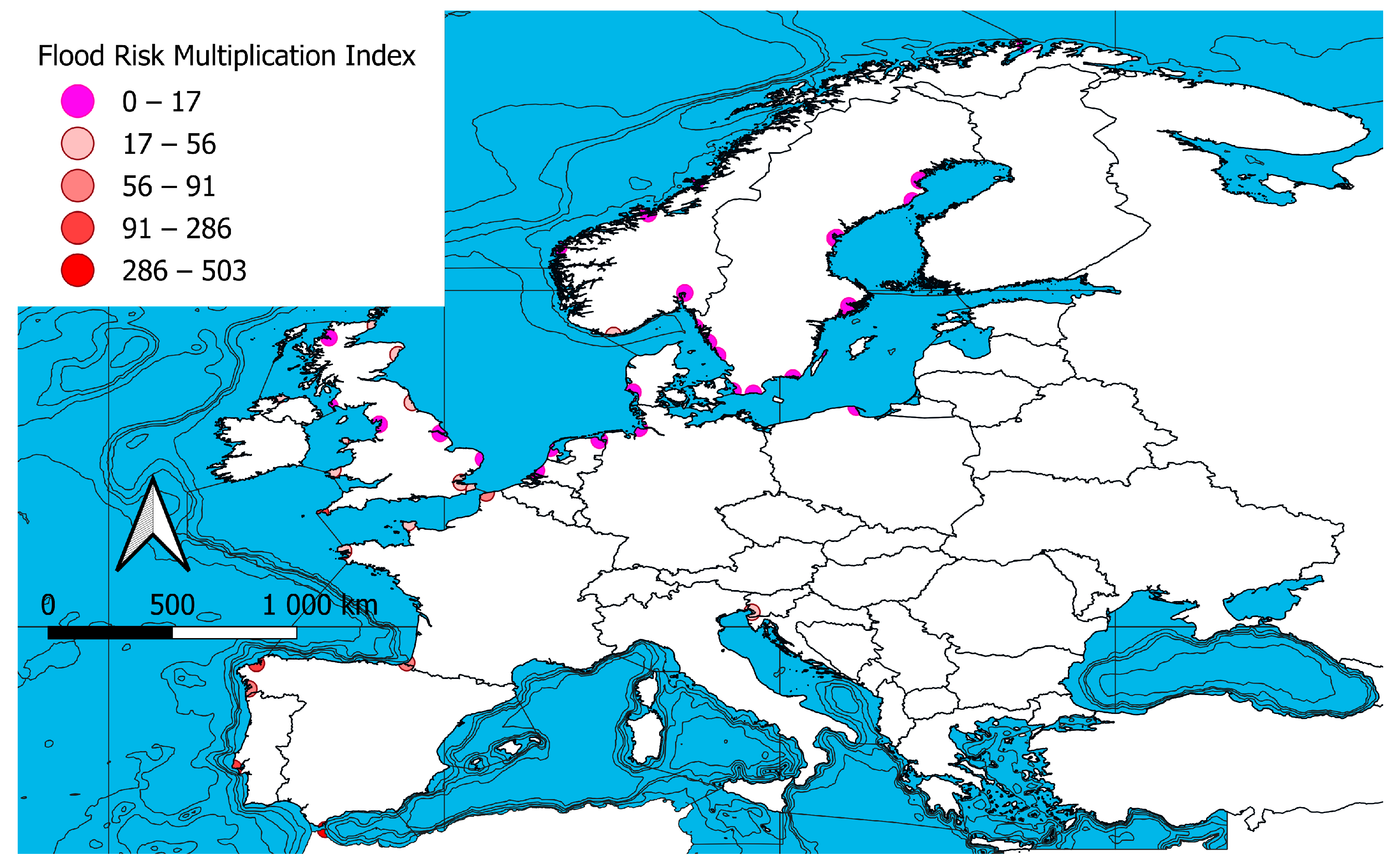
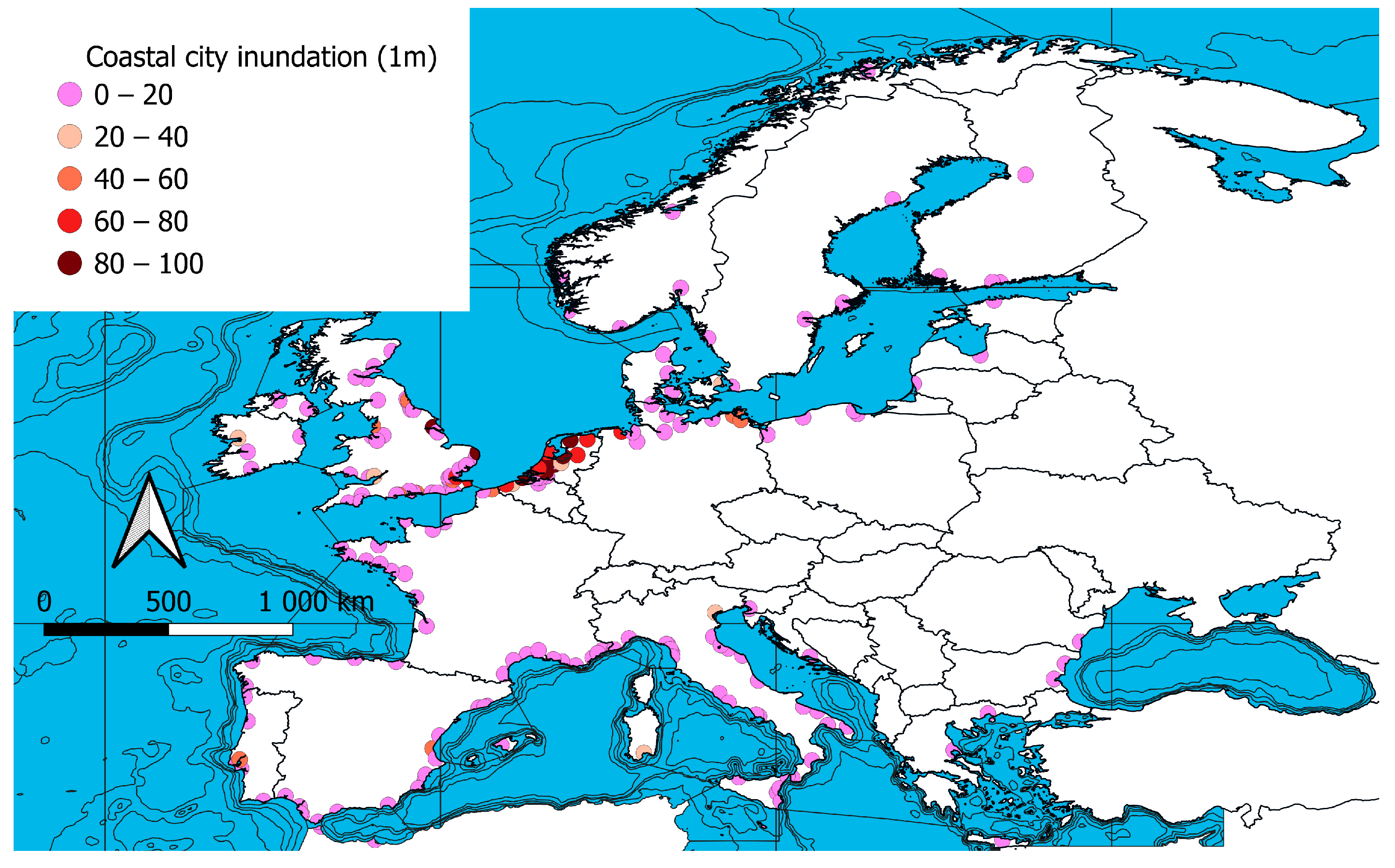
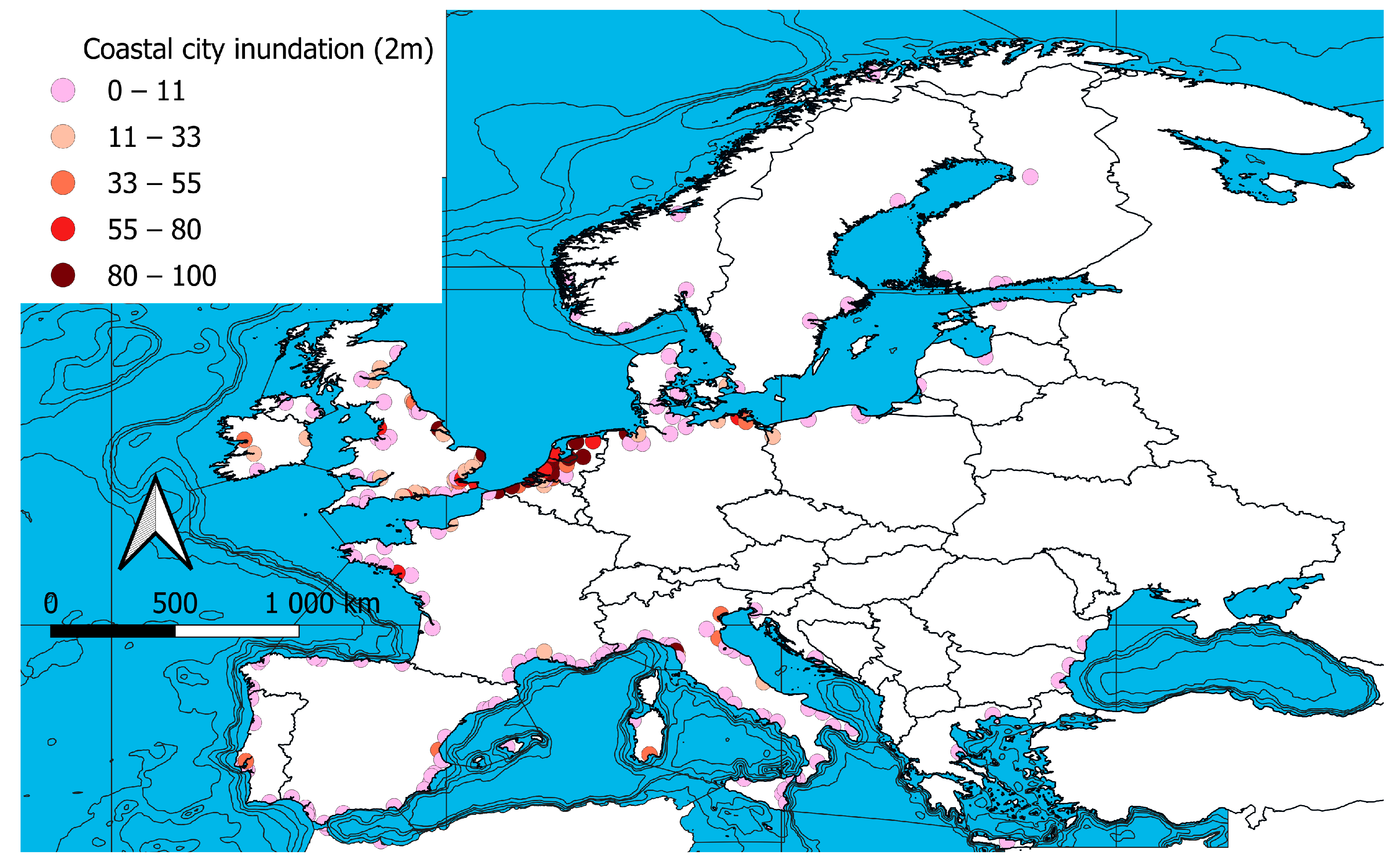
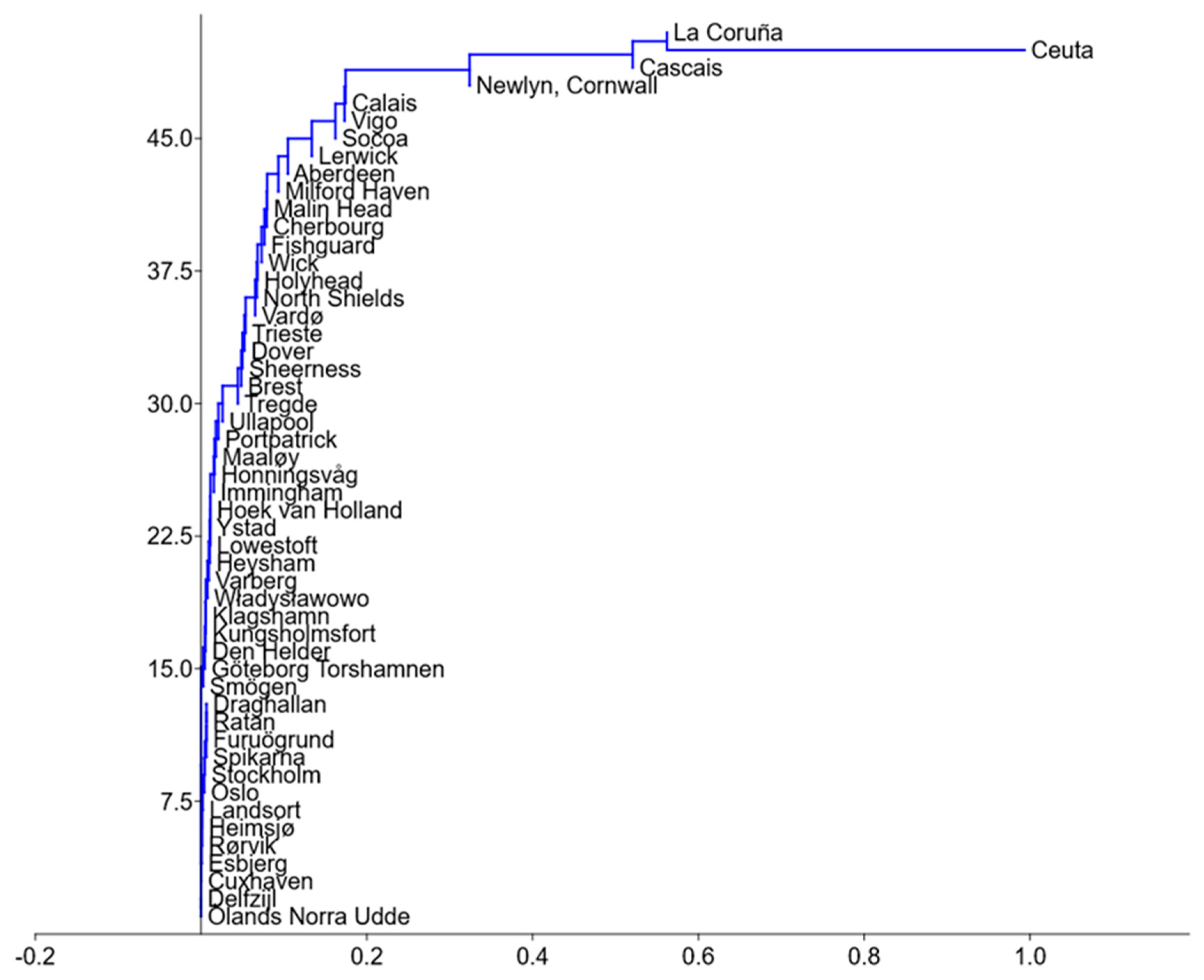

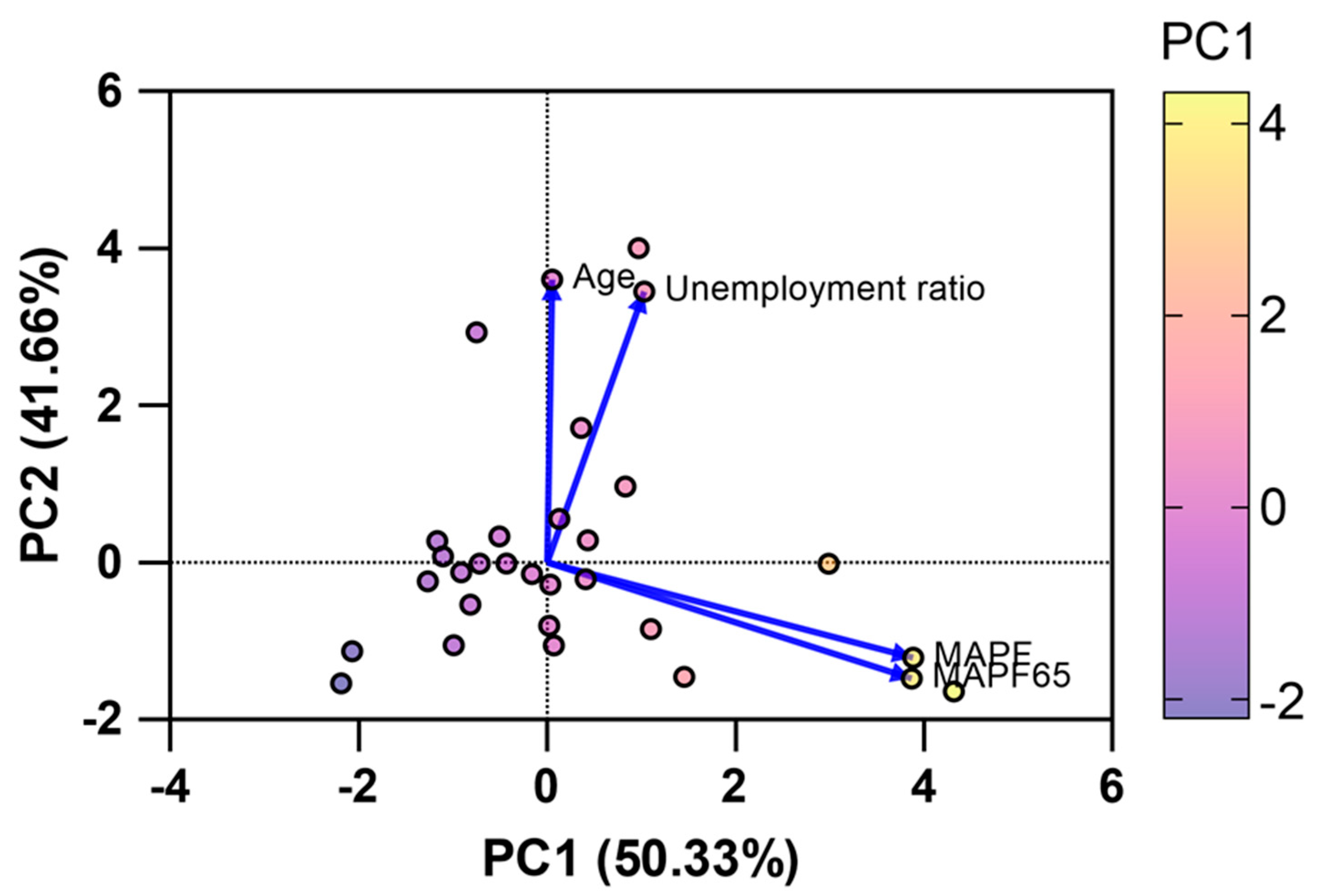
| Metric | 1 m Rise | 2 m Rise | Statistic | Value | Interpretation |
|---|---|---|---|---|---|
| Sample size (N) | 223 | 235 | - | - | |
| Mean rank | 105.96 | 123.54 | - | - | |
| Mann–Whitney U test | - | - | U | 23,56 | |
| z-statistic | - | - | - | 1.8693 | |
| p-value | - | - | - | 0.061586 | |
| Monte Carlo p-value | - | - | - | 0.0647 | |
| Effect size (Vargha–Delaney A) | - | - | Effect Size (A) | 0.4495 | Small (slight preference for 2 m values being larger) |
| Brunner–Munzel test | - | - | phat | 0.55051 | |
| BM statistic | - | - | - | 1.8766 | |
| Degrees of freedom | - | - | - | 447.71 | |
| p-value | - | - | - | 0.06123 | |
| Monte Carlo p-value | - | - | - | 0.0643 |
| Test | Metric | 1 m Rise | 2 m Rise | Statistic | Value | Additional Info |
|---|---|---|---|---|---|---|
| Mood’s test | Sample size (N) | 223 | 235 | Chi2 | 1.258 | |
| p (same median) | 0.261 | Fisher’s exact p = 0.261 | ||||
| W test (distributions) | Sample size (N) | 223 | 235 | W | 3.121 | p (same dist.) = 0.537 |
| Distributions are not significantly different | ||||||
| Fligner–Killeen test | Sample size (N) | 223 | 235 | CV | 156.71 | 143.49 |
| 95% Confidence interval | (138.01, 173.13) | (127.7, 157.43) | T | 246.48 | Expected T = 219.37 | |
| z | 1.866 | |||||
| p (one-tailed) | 0.031 | |||||
| p (two-tailed) | 0.062 |
| Metric | 1 m Rise | 2 m Rise | Statistic/Parameter | Value | Comments |
|---|---|---|---|---|---|
| Sample size (N) | 223 | 235 | Larger sample size for 2 m rise | ||
| Mean area | 18,431 | 21,384 | Higher mean area for 2 m rise | ||
| 95% Confidence interval | (14,619; 22,242) | (17,441; 25,328) | Overlapping intervals indicate similarity | ||
| Variance | 834.17 | 941.49 | Slightly higher variance for 2 m rise | ||
| Difference of means | 2.953 | Small difference between means | |||
| 95% CI (parametric) | (−2.5249; 8.432) | Indicates substantial overlap | |||
| 95% CI (bootstrap) | (−2.5193; 8.452) | Similar findings via bootstrap method | |||
| t-statistic (equal variances) | 1.059 | Supports evidence for equal means | |||
| p-value (equal variances) | 0.289 | Not statistically significant | |||
| t-statistic (unequal variances) | 1.061 | ||||
| p-value (unequal variances) | 0.289 | Consistent with equal means evidence | |||
| Monte Carlo permutation p-value | 0.291 | ||||
| Bayes factor | 0.178 | Substantial evidence for equal means | |||
| Cohen’s D | 0.099 | Very small effect size; negligible difference | |||
| Epps–Singleton test | W Statistic | 3.12 | Distributions are not significantly different | ||
| Parameter type | N | N | Mean | 13 | |
| Standard deviation | 11 | 11 | Similar dispersion for both rises |
| Outlier | Rcrit | R | Value | Row |
|---|---|---|---|---|
| Yes | 3.136 | 5.233 | 502.8 | Ceuta |
| Yes | 3.128 | 4.256 | 285.9 | La Coruña |
| Yes | 3.12 | 5.024 | 265.2 | Cascais |
| Yes | 3.112 | 4.387 | 166.3 | Newlyn, Cornwall |
| Yes | 3.103 | 2.778 | 91 | Calais |
| Yes | 3.094 | 3.058 | 90.4 | Vigo |
| Yes | 3.085 | 3.215 | 84.9 | Socoa |
| No | 3.016 | 2.938 | 70.6 | Lerwick |
| No | 3.06 | 2.444 | 56.1 | Aberdeen |
| No | 3.057 | 2.294 | 50.3 | Milford Haven |
| VIF | 95% CI | Standard Error | Estimate | Variable |
|---|---|---|---|---|
| - | −0.6531 to 2.727 | 0.8127 | 1.037 | β0 (Intercept) |
| 2.038 | −1.391 to 1.368 | 0.6633 | −0.01165 | β1 (Age) |
| 1.182 | 0.8179 to 1.005 | 0.04501 | 0.9115 | β2 (MAPF) |
| 6.704 | −1.460 to 0.8833 | 0.5633 | −0.2882 | β3 (Unemployment Ratio) |
| 7.0 | −0.04919 to 0.06613 | 0.02773 | 0.008471 | β4 (Age: MAPF: Unemployment) |
Disclaimer/Publisher’s Note: The statements, opinions and data contained in all publications are solely those of the individual author(s) and contributor(s) and not of MDPI and/or the editor(s). MDPI and/or the editor(s) disclaim responsibility for any injury to people or property resulting from any ideas, methods, instructions or products referred to in the content. |
© 2025 by the authors. Licensee MDPI, Basel, Switzerland. This article is an open access article distributed under the terms and conditions of the Creative Commons Attribution (CC BY) license (https://creativecommons.org/licenses/by/4.0/).
Share and Cite
Halecki, W.; Bedla, D. Flood Exposure Patterns Induced by Sea Level Rise in Coastal Urban Areas of Europe and North Africa. Water 2025, 17, 1889. https://doi.org/10.3390/w17131889
Halecki W, Bedla D. Flood Exposure Patterns Induced by Sea Level Rise in Coastal Urban Areas of Europe and North Africa. Water. 2025; 17(13):1889. https://doi.org/10.3390/w17131889
Chicago/Turabian StyleHalecki, Wiktor, and Dawid Bedla. 2025. "Flood Exposure Patterns Induced by Sea Level Rise in Coastal Urban Areas of Europe and North Africa" Water 17, no. 13: 1889. https://doi.org/10.3390/w17131889
APA StyleHalecki, W., & Bedla, D. (2025). Flood Exposure Patterns Induced by Sea Level Rise in Coastal Urban Areas of Europe and North Africa. Water, 17(13), 1889. https://doi.org/10.3390/w17131889








